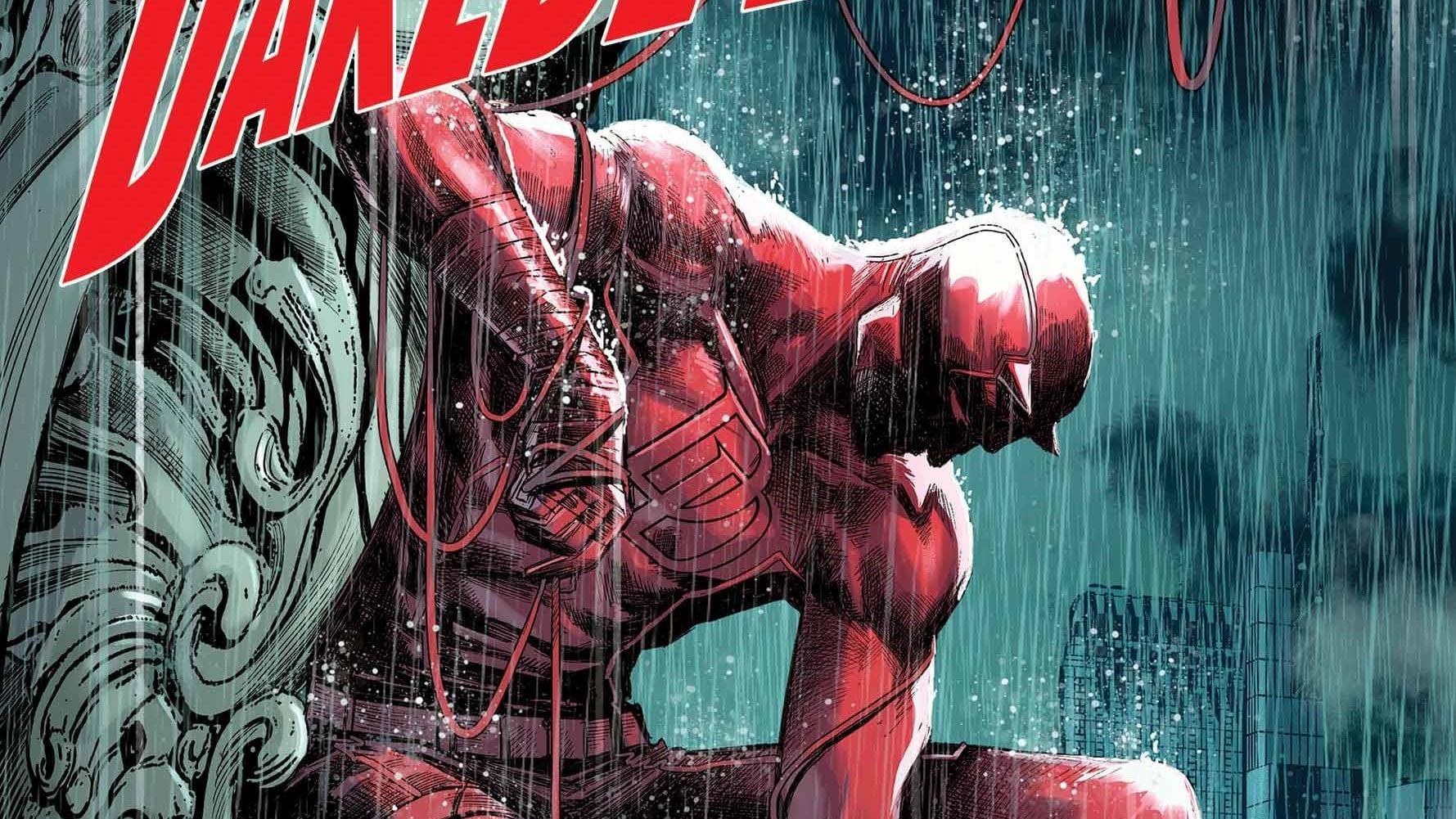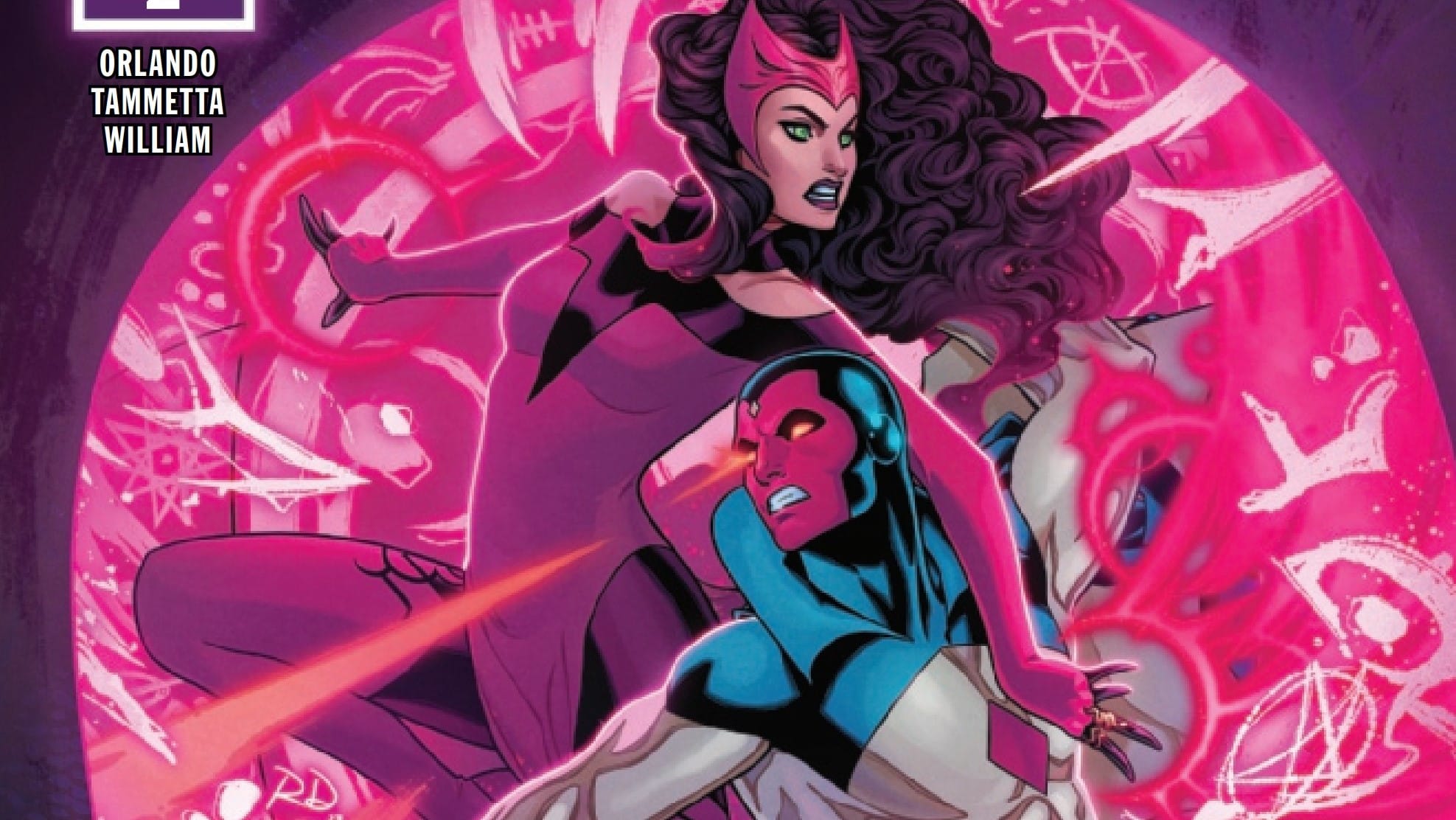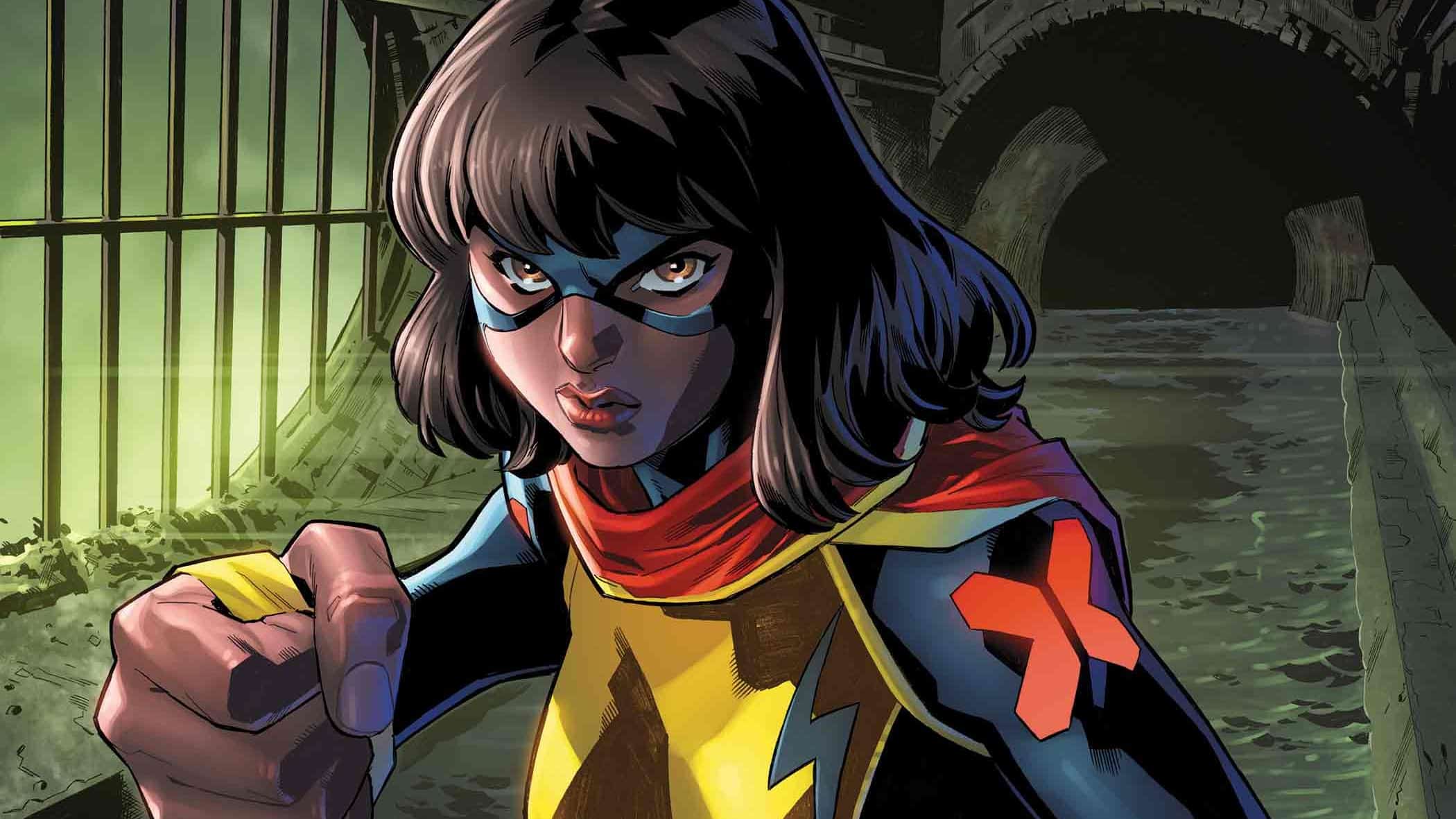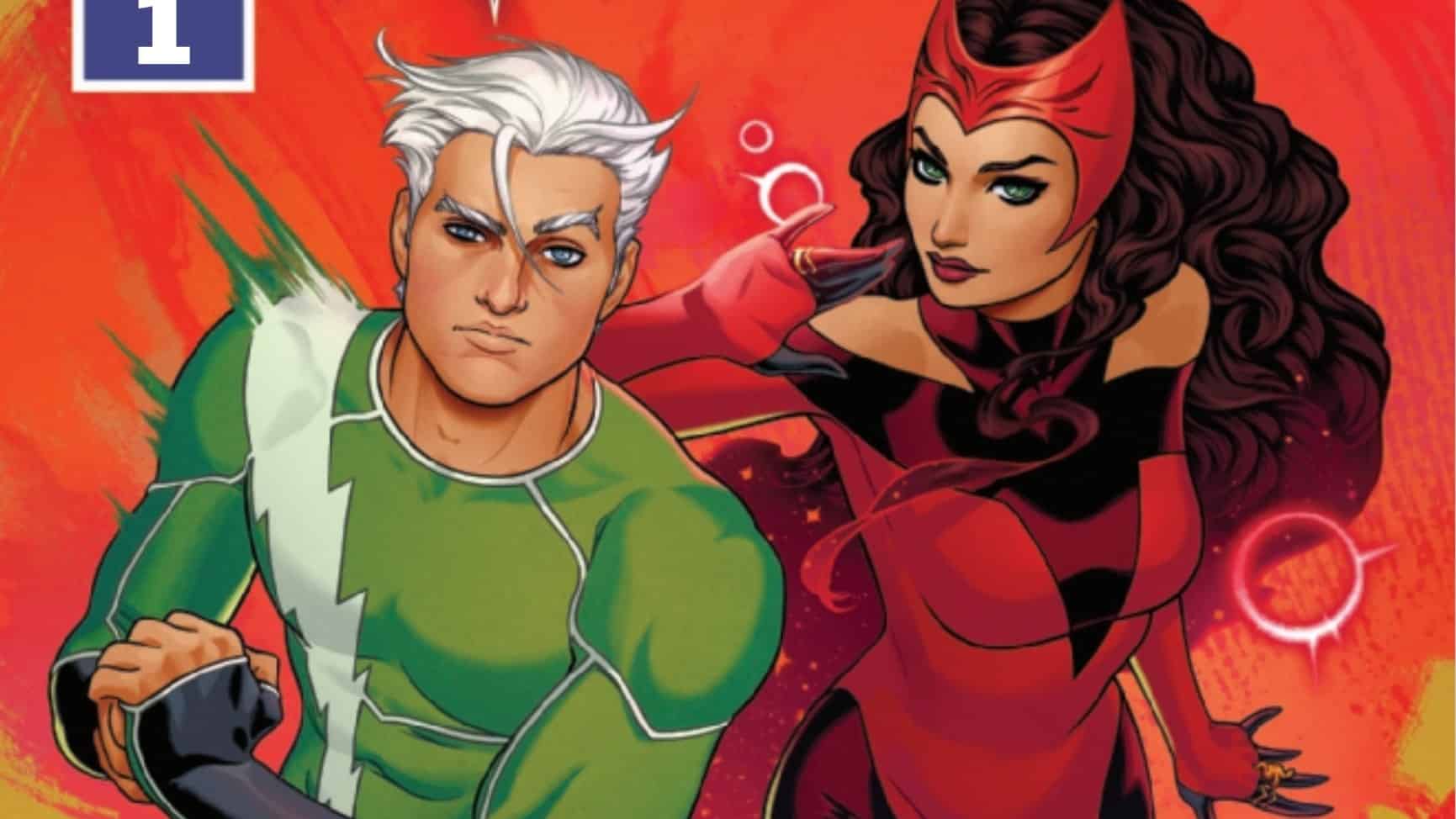Daredevil never really left but he’s back anyway, and so is Daredevil #1! Matt and Elektra have big plans to save the world, but they can’t do it from Hell’s Kitchen. Matt’s guardian angel wants to help–or does he…? Daredevil #1 is written by Chip Zdarsky, drawn by Marco Checchetto and Rafael De Latorre, colored by Matthew Wilson, lettered by VC’s Clayton Cowles.
Anna Peppard: Relaunches are funny. Not “ha ha” funny but funny in the sense of—it’s a strange phenomenon that only really makes sense to experienced readers of serialized superhero comics, and even then, it doesn’t really make sense, because every relaunch is different. Some relaunches are reboots that attempt to dramatically reshape the status quo. Some are continuations that happen for the sake of trade paperback republishing or in the hopes of getting a sales boost or recruiting new readers.
Daredevil #1 is more of the latter, with a dash of the former, depending on your feelings about what’s in store and how it plays out. We’ll get into the high and lows and nuances below, but my pull quote for this issue is: it’s a solid debut that would probably feel more exciting to me if it didn’t also feel like more of the same. None of that is a bad thing; there’s definite promise in the setup, we’ll hash it out.
But while the Daredevil creative team is (largely) unchanged, the CXF review team is welcoming fresh talent, as I’m joined for monthly coverage by the one and only Rasmus Lykke! Excited to talk hornhead with you, Rasmus!
Rasmus Lykke: Thanks, Anna! I’m excited to be here. I’m a longtime Daredevil fan and I’ve been loving Zdarsky’s run on DD, so I’m looking forward to taking a closer look at it, with this new volume.
I agree with you that this relaunch isn’t really a huge deal, since it doesn’t bring a totally new direction, more of a realignment of the story. But when the story has been this good, I’m not complaining.
Let’s get into it!
Hello, Goodbye

Anna: Daredevil #1 opens by catching up with Matt & Co. in the wake of Devil’s Reign interspersed with flash-forwards to a seeming interrogation, wherein a grizzled, bearded Daredevil is defending the garden of righteous violence he and Elektra have built (grown?) in order to save the world. This is presumably in relation to Matt’s agreement at the end of Devil’s Reign to help Elektra rebuild the order of the Fist to take down the Hand. Matt insists his “people” aren’t soldiers; his interrogator disagrees. At the end of the issue, we see Elektra arrive at their new base of operations on the formerly Japanese, currently Russian controlled island of Makanrushi, which we’ll discuss in due course. Also, the Punisher will apparently be involved, which I’m not initially excited about, but that’s another topic for another time.
But before heading for Makanrushi, Matt needs to tie up some loose ends. This includes taking a meeting with Butch Pharris in which he briefly pretends to be his magical twin brother Mike. (If you don’t already know the deal with Mike, you’ll have to Google it!)
It also allows Checchetto to draw maskless Matt Murdock for a bit, and I know I said this a million times when writing about the previous volume, but given how much time Matt spent in his grimy mask during the Daredevil-goes-to-prison storyline, I’m so happy to see his face. Don’t get me wrong, Matt has the best costume in Marvel comics (fight me!). But there’s something important about the contrast between Matt’s human delicacy and his superhero hardness. Brian Michael Bendis often had characters describe Matt as “beautiful” (not handsome) and that’s always stuck with me. Both identities are different kinds of masks and cultural ideas, and I like it when artists get to play with that contrast, as Checchetto does here when beautiful Matt suddenly becomes Daredevil, snarling and pulling on his (literal) mask.
On a plot level, Matt’s meeting with Butch allows him to learn the truth about Wilson Fisk—that he’s not really dead, but is, like Matt, merely pretending to be, because everyone needs a break from all the responsibilities of existing once in while, right? But Matt quickly drops the ruse to rough up Butch and his buddies with the help of his own buddy—none other than your friendly neighborhood Spider-Man.
You see, the other really important thing Matt needed to do before starting the new life that he’s clearly really excited to start is spend a bro night hanging with Spidey, doing bro stuff—like swinging around Hell’s Kitchen roughing up goons, reminding them not to get too goon-y, or whatever the point of this kind of stuff is supposed to be. Pardon my cynicism, but parts of this feel like a bit of a step back from where I hoped we might be going in the last series. Remember all that stuff about how justice isn’t fair and maybe we should rethink the ways we punish people? That’s obliquely referenced here, in Matt reflecting on the sometimes-tragic backgrounds of the goons he’s beating up. (Side note: while I can buy Matt researching Butch’s encourage, it reads a bit like Matt’s sensory powers are getting confused with telepathy or Benedict Cumberbatch-as-Sherlock-Holmes powers here.) But while I guess it’s nice to know Matt feels bad about punching people, on a practical level, he’s doing the exact same stuff he’s always done.
On the one hand, this feels typical of Zdarsky’s Matt, who has always seemed flat-out determined to never learn any of the right lessons from anything. On the other hand, mileage on this take may vary. Thoughts on the set-up, Rasmus?
Rasmus: Matt is a character that is very much determined by his stubbornness, which definitely comes to the forefront here. Though to a large degree, the real reason why Daredevil and Spider-Man are beating up bad guys is simply because it looks cool. These are superhero comics, a certain level of violence is to be expected, even if it’s sometimes (like… 80% of the times) gratuitous.
In my eyes, Zdarsky and Checchetto do a pretty good job of selling Matt’s new outlook, both through the captions, where he mentions being more careful, and through the art, where the punches do seem somewhat softened. Matt’s taking them down, he’s not beating them up. A subtle distinction, but one that I think is there. It’s also aided by Spidey taking down a few thugs with his webbing, a pretty non-violent solution by superhero standards.
Speaking of Spidey, I’ve always enjoyed his and Matt’s friendship. There’s not a lot of people either of them can talk to about their problems, who actually knows what they’re going through, and they’ve found that in each other. It makes sense for Matt to turn to Spidey at this point – even revealing his identity to him, bonding the two further – both to unload and recharge, but also as using Pete as a guiding light for how he hopes the city will fare without him. Pete’s a lighter, more hopeful hero, which is what Matt’s hoping to be going forward. Whether or not he’ll succeed is another matter entirely.
Daredevil’s night out with his friend does come at a cost, though.
Anna: Matt has so much fun getting physical and emotional with Spidey that he forgets to say goodbye to Kirsten McDuffie, who still doesn’t know DD and Matt are one and the same – though she shared a passionate kiss with DD back in Devil’s Reign that suggests maybe she does? I’m assuming this little whoopsie will have no serious consequences whatsoever!
I Saw Her Standing There

Anna: But you know what they say about assumptions… Turns out, forgetting to meet Kirsten has some very serious consequences, including her death, maybe? For now, I’m going to assume (and hope against hope) that Kirsten isn’t actually dead. If she is, I’m going to be pissed, but I’ll save that rant until we know for sure what’s gone down. In any case, it is clear that a bunch of people are dead, the result of an explosion on a train that this arc’s villain, Robert Goldman, aka “Goldy,” either caused or failed to prevent, though it appears to be the former.
Rasmus: Yeah, the pre-credits scene with Goldy does make it seem like he has vast powers, able to foresee the future and how even small events can have huge consequences. It’s even hinted that he might’ve been connected to the accident that gave Matt his powers. He’s an interesting character in this issue. For those in the audience who might not recall his story up to now (like me), could you give a refresher, Anna?
Anna: Sure! He was co-created by Zdarsky, first appearing in Daredevil #22 (2020). He was the lawyer who prosecuted Daredevil for murder, and in Zdarsky’s previous run and the recent Daredevil: Woman Without Fear (2022), similarly penned by Zdarsky, he was additionally retconned into Matt, Foggy, and Elektra’s backstory as a classmate of Matt and Foggy when they attended law school at Columbia.
Now, Goldy has superpowers. His voice narrates much of the issue, and through that narration, we learn his powers are partly based in precognition; he knows that certain things, especially things related to Matt Murdock, will happen, and when they’ll happen. He presents himself as Matt’s guardian angel, but only Matt’s. The implication is that he somehow kept Matt distracted in order to prevent him from meeting up with Kirsten, saving Matt’s life but doing nothing to prevent Kirsten or anyone else’s (seeming) death. Despite my feelings about Kirsten’s possible fate, there’s some interesting rhetorical potential here, between reactive and proactive approaches to justice, or selfish and selfless love. Are you intrigued by Goldy, Rasmus?
Rasmus: I am, actually.
He’s presented as an actual guarding angel–helped by his golden captions–and even if I suspect that won’t actually turn out to be the truth (Marvel is too big a company to allow such direct depictions of Christian figures), it’s a very interesting angle for Matt. Religion has been a huge part of the character for so long and I think it often leads to interesting conundrums for Matt, as he’s forced to reconcile his actions with his religion.
And, to be fair, his powers are just cool. Knowing the future and being able to either change it or ensure it comes about simply by rolling a pebble is pretty awesome.
That being said, if he did kill Kirsten, I’m a lot less fond of him. But I doubt it. We don’t see her on the train and we don’t see her corpse. And it’s as true of superhero comics, as Taylor Swift songs: No body, no crime.
Anna: Before heading to Makanrushi with Elektra, we touch base once more with grizzled future-Daredevil getting interrogated. This sequence suggests Goldy will join Matt’s not-army. Matt also says Goldy is the only person he’s afraid of–other than God. This is clearly an attempt to give Goldy some heat as a villain, but I can’t quite convince myself to agree with this characterization of Matt.
To my mind, Matt isn’t afraid of God. If he thought it might save one good person in Hell’s Kitchen, Matt wouldn’t think twice about challenging God to a fight; then he’d go to hell and fight the devil. To the extent Matt has Catholic guilt, he’s not guilty because he’s God-fearing; he’s guilty because he isn’t. I’ve often had issues with Zdarsky’s version of Catholic Matt, which feels, to me, more inspired by cliché than culture or character. But of course, character reads are subjective. Maybe other readers get more out of it than I do, and fair enough.
Rasmus: As someone who A) is an atheist (or, at best, an agnostic) and B) lives in a country where Catholicism isn’t a big thing, I have no real reference for it, other than pop culture. So I haven’t really noticed any flaw with the depiction here. It feels like the usual depiction in Daredevil comics to me. Whether or not that’s a good thing, I can’t rightly say.
I do, however, agree with you. Matt would totally fight God.
Tomorrow Never Knows

Anna: We conclude, as promised, with a vignette catching up with Elektra, arriving on Makanrushi in the only acceptable way for a person as cool as her to do so–by jumping out of an airplane without a parachute, soaring through the air into a perfect soft landing in a field of snow. The artist for this vignette is Rafael De Latorre, who also worked on Elektra: Woman Without Fear, lending some nice visual consistency to her ongoing story. The kinetic fight scene here, between Stick and Elektra, was probably my favorite part of the issue. I like Checchetto’s art a bunch but for me, sometimes, his fight scenes feel a bit crowded and heavy and not quite agile enough for characters like DD and Elektra. (I want to be clear, this is purely a personal preference, not a question of skill or artistry.) De Latorre’s fight scene is a nice contrast.
Rasmus: I don’t feel the same way about Checchetto’s art, but I do agree that De Latorre’s fight scene is the most exciting in the issue. It moves and flows wonderfully. I think another key part of why it works as wonderfully as it does, is the excellent work by the one new member of the creative team: colorist Matthew Wilson.
In the Elektra portion of the issue, he really shines. It might just be subject matter, but it reminds me of his work with Chris Samnee on Fire Power. There’s some of the same color palette at work here, but the thing that really works is how Wilson switches between warm and cold colors, making the impact panels hit that much harder. It’s great work, which shows why he’s one of the best in the business. Team Daredevil is lucky to have him on board.
Anna: Elektra interior monologues about how glad she is to be out of the noisy, smelly city, how she doesn’t know how Matt can stand it, and how much happier he’s going to be retreating to the middle of nowhere. Now, I’m no relationship counselor, but the fact Elektra clearly doesn’t understand what Matt likes does not, methinks, bode well for her romantic dreams of hermetic (but sexy) assassinry (or whatever they’re up to now that Elektra doesn’t kill). Matt doesn’t hate the noise and smell of the city. He loves it. Learning to love it is how he learned to love his powers. None of this is a criticism; I’m here for Matt/Elektra relationship drama, if that’s where we’re headed. I mean, relationship drama is almost an oxymoron where Matt and Elektra are concerned. Their relationship is drama.
But speaking of criticisms… I almost don’t want to say it because it’s such a boringly obvious critique, but–white people setting up shop in Japan (or former Japan, in this case) to be good ninjas fighting the bad kind of ninjas is a plot I’m not super excited to see again. (And again, and again.) I wouldn’t mind comics feeling a little less beholden to the appropriative parts of Daredevil’s history that were introduced by a demonstrably racist writer (Frank Miller), but maybe the story will subvert my expectations, we’ll see.
I am, however, glad it looks like Elektra is going to be maintaining a strong presence in the book moving forward. What’s your mileage on Elektra’s new dream home, Rasmus?
Rasmus: I must admit I’ve never been a big Elektra fan. Maybe I just haven’t read the right stories, but to me she’s always just seemed like “cool, sexy, ninja assassin lady”. Which is, y’know, fine. I don’t dislike her, but there’s just not much there, really. I do like the direction Zdarsky has taken her recently, though. With her trying to get closer to Matt and his way of life, which is far removed from her own. So despite her not really understanding what Matt likes, she is at least trying. And trying to be a better person. That’s always interesting.
If doing so in the middle of the Russian tundra, with The Fist and Stick is the right choice… I doubt it. But we’re not here to read about people making the right, smart decisions, are we? We’re here for interesting drama and the new status quo of Daredevil has plenty of potential for that.
In the end, a lot of the issue is tying up loose ends and only hinting at new beginnings. But that being said, I think that both past experience and the craftmanship of this issue, shows us that there’ll be plenty of excitement and drama ahead for the two Daredevils.
Anna: See you in 30 for #2! (Or however many days it takes to find enough paper to print it!)
Marvelous Musings:
- It’s interesting that Elektra is still wearing her Daredevil costume. She’s not filling in for Matt anymore, not being a symbol for Hell’s Kitchen. But she’s still wearing the costume. This is relevant to where she’s at as a character, and I look forward to learning more of what it means.
- Are there people out there who really love the character of Stick? I (Anna) am not a fan of him beyond his initial appearances. But if he has an enormous passionate fanbase I’m not aware of, I stand corrected!
- Am I (Anna) going to have to catch up with Punisher comics to keep reviewing this series? Please tell me I’m not going to have to catch up with Punisher comics to keep reviewing this series.
- (Rasmus: Yeah, I’m afraid so. Daredevil is running The Fist and the Punisher is running The Hand. They’re bound to clash sooner than later.)
- ☹️☹️☹️ (<Anna)
- As I alluded to above, Makanrushi was once part of Japan but is currently part of Russia, which is why we see Russian soldiers investigating Elektra and Stick’s little shack. Stick kills the guys, but won’t Russia just keep sending more…? It’s funny to me that they’ve been at their top secret hideout for five minutes and their cover is already blown.
- The awkward energy in that shack is going to be intense. I hope, for everyone’s sake, they get to trade up in the near future. Matt and Elektra kinda need their own room(s). (Aren’t you happy I didn’t say their own love shack whoops I said it anyway.)







